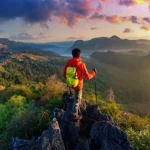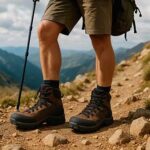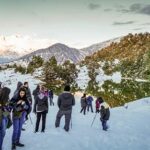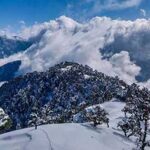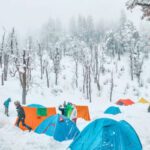
What items should I pack for trekking in the Himalayas? It is a common query every beginner trekker has before venturing on a Himalayan trek.
You also have this question. Right?
Carrying the appropriate gear on the trek is the deciding factor in the success of your trek. Therefore, while packing trekking essentials, you must thoroughly research and only pack what is needed.
However, due to a lack of trekking experience and information, it might be challenging to pick appropriate trekking gear.
But don’t worry! I am here to help you pack the essential trekking items you require on the Himalayan trek.
In this blog, I have listed three categories of trekking essentials for beginners with all the vital trek items. This list is based on my years of trekking experience in the Himalayas.
Must-Have Trekking Essentials For Beginners In the Himalayas
To start preparing for the trek, consider the following trekking essentials.
1. Backpack With Raincover

A backpack is first on the list of things needed for trekking as it carries all the other items during your trek. But what kind of backpack should you choose?
To pick an ideal trekking backpack, consider the below-listed factors;
- Size 55Litre to 65 Litre
- Adjustable waist and shoulder straps for better support
- Adjustable padding on the back
- Rain cover
- Easy Access Pockets
In addition, make sure you buy a backpack from one of the following brands;
I recommend these companies because they make high-quality and technically sound backpacks. Also, I have used and tested backpacks from various brands, including local manufacturers.
2. Trekking Shoes With Ankle Support
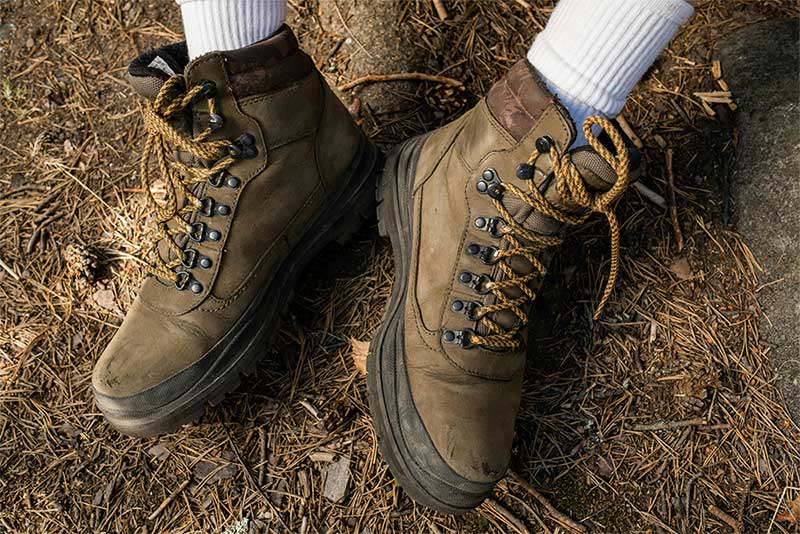
If you want to make your trek journey a lifetime experience by reducing the chances of injury, trekking shoes are a must.
Trekking shoes have high ankle support, which keeps your feet firm and avoids ankle twisting. Their thick sole provides cushioning, absorb shock, and reduce strain on the legs. In addition, they have excellent grip to save you from slipping on the trails.
Decathlon is the only brand in India offering a range of affordable trekking shoes. They have trekking shoes for every budget.
To learn more about trekking shoes, read this detailed blog: Trekking Shoes – How to choose the right pair?
3. Pair Of Trekking Poles

Although trekking poles are not mandatory, using them on the trek can significantly help you.
There are three prime reasons for using trekking poles;
- Provide Stability and Support during the trek
- Reduce Strain On Legs
- Offer firm grip while trekking on snow and steep slopes
Furthermore, using trekking poles also reduces your energy consumption remarkably.
4. Poncho (Rain Jacket)

The weather in the mountains during the trek is usually unpredictable. Therefore, you must be prepared for all situations, especially rain and snow.
Carrying a poncho is the only way to prepare for such a situation.
A poncho is a rain cover made explicitly for trekking. It’s enormous and has openings for the head and hands. Additionally, it covers your whole body and backpack easily.
The best thing about the poncho is its lightweight and high compatibility despite its vast size.
You can find ponchos in any shop selling trekking essentials for beginners. However, I suggest you buy from Decathlon because of its easy availability and high quality.
5. Headlamp

As you already know, you won’t find electricity on the trek. Hence, it would help if you have a headlamp to navigate in the dark at the campsite and on the trek.
But make sure you don’t mistake a torch for a headlamp.
Using a torch during the trek makes doing things with your hand challenging. Conversely, using a headlamp, you can do anything with your hands, including eating food, packing things, setting up a tent, etc.
6. Water Bottle Or Hydration Pack

Trekking in the Himalayas involves hiking for long hours(approx-6 hours) without much water sources, leaving you dehydrated. For this reason, it’s vital to carry two one-litre water bottles.
Here, I suggest carrying one usual water bottle and one thermos bottle. Thermos keeps water warm for longer, which is very helpful on cold days.
You can replace one water bottle with a hydration pack. But practice using it and get comfortable before venturing on the trek.
7. First Aid Kit
Trekking in the Himalayas takes you to remote locations with no medical facilities.
Thus, carrying a first aid kit to handle any medical emergency would be best. The first aid kit must contain necessary medicine and basic medical supplies.
Here are the basic things your first aid kit must have;
- Bandages
- Scissors
- Cotton
- Antibiotic Ointment
- Thermometer
- Oxymeter
- Petroleum Jelly
- Eye and Ear Drop
- Duct Tape
- Hand Sanitizer
- ORS
- Antacids like Digene
- Cough and Cold medicine like Vicks
- Pain Relievers such as ibuprofen or paracetamol
- Anti- Allergic medicine
- Diarrhoea Medicine
- Ointment For reducing swelling or muscular pain
A first aid kit must be a part of your trekking essentials for beginners list.
8. Sunglasses
Sunglasses are helpful during a bright sunny day and trekking in the snow.
Sunglasses protect your eyes from harmful exposure to UV rays, especially during snow trekking when the chances of snow blindness are very high.
The snow in the daytime reflects direct UV rays with high intensity, which can damage your eyes, leading to snow blindness.
So, you need sunglasses with UV protection wholly wrapped around your eyes. Nevertheless, if you wear loose sunglasses, UV rays damage your eyes.
Your first list of trekking essentials for beginners is complete, and now let’s move to the second one related to clothing.
Trek Clothing Checklist
When you trek in the Himalayas, cold weather bothers you most. Thus, wearing layers of clothes is the key to keeping yourself warm.
You must carry the following clothes with you on the Himalayan treks to complete your trekking essentials for beginners checklist.
1. Pair Of Trek Pants

Carry at least two trek pants: one to wear and a second for backup. Trek pants are made explicitly for trekking; hence, they are sturdy, lightweight, dry quickly, and can be packed compactly.
Moreover, they have multiple pockets and zippered cut-offs at the thighs.
2. Three Dry Fit T-Shirt
Consider three full-sleeved dry-fit t-shirts with a collar for your trek. The full sleeve and collar protect your arms and neck from sunburn.
Avoid using a cotton T-shirt, as it takes very long to dry. More prolonged drying keeps your body wet for an extended time and hence can make you fall ill during the colder days.
3. Thermals
As the weather in the Himalayas is usually cold, you must keep your body warm, especially at night.
One pair of thermal will suffice. You can get thermal at any shop near you at an affordable price.
4. Fleece Jacket

Fleece Jacket is made of synthetic insulating fiber, typically polyester. It is lightweight, comfortable, warm, and has quick dry features.
You can wear fleece over a t-shirt throughout the day during your trek.
5. Padded Warm Jacket / Feather jacket

To keep yourself warm during snow trekking, you must carry a padded warm jacket, also known as a down jacket. It is generally layered above fleece for a practical warming effect.
The market is flooded with feather jackets, but I suggest buying them from a store selling trekking essentials for beginners.
6. Woollen Cap or Balaclava
A Wollen cap is required after sunset, in the early morning, or on cold days. It should cover your head and ears altogether to avoid losing any heat.
You can replace the wollen cap with a balaclava, primarily made for adventure activities.
7. Synthetic Hand Gloves
You need synthetic hand gloves while trekking in the snow and during cold weather. Wearing gloves helps you grip things firmly and keep your hands warm.
Synthetic gloves are readily available in stores like Decathlon, which sells trekking gear.
Tip: You must avoid using wollen gloves as they get wet quickly, take a long time to dry, and lack good grip.
8. Socks – 3 pairs
You need two pairs of sports socks and one pair of woollen socks.
Sports socks are used during trekking hours, and woollen socks are used at night to keep your feet warm.
9. Sun Cap
If you want to save yourself from headaches, sun strokes, and dehydration, using a sun cap during a trek is necessary.
A sun cap protects your head from the harsh sun rays. In addition, it helps maintain your body temperature.
So, buy a lightweight and quick dry sun cap for trekking in the Himalayas.
You can buy all the clothes mentioned in the above list from a single trekking store like Decathlon, as it offers a variety of options with different price ranges.
Accessories Checklist
Last on the list of trekking essentials for beginners are the accessories that may look tiny in size but have significant use on the trek.
1. Toiletries
Toiletries items are essential to keep you hygienic on the trek. Include a toothbrush, toothpaste, soap, toilet tissue roll, moisturiser, lip balm, and deodorant in your toiletry kit.
Try to carry mini-sized items to save space and pack light.
2. Powerbank
You must carry a power bank to keep your gadgets, including your phone, charged during a trek to capture lifetime moments.
You can opt for any power bank with high efficiency at high altitudes and in cold weather. Moreover, it should have a high charging capacity per your gadget’s needs.
3. Sunscreen
Trekking in the Himalayas means high exposure to harmful UV rays. Therefore, you must carry a good sunscreen with a SPF above 30.
4. Slippers
Putting on trekking shoes at the campsite is a cumbersome task. So, a pair of trekking slippers can replace them.
With slippers, your feet dry quickly, and you can easily navigate at the campsite. It’s even easier to get in and out of the tent.
While selecting sleepers, ensure they are;
- Sturdy
- Light Weight
- Well Cushioned with a good grip
5. Mandatory Documents
Last on this list of trekking essentials for beginners are the mandatory documents such as identity proof and medical certificate. You must carry a photocopy of them, which is generally required for a forest permit.
FAQs About Trekking Essentials For Beginners
How do you pack for 7 day trek?
First, make a list of things needed for trekking. Your list should include a backpack, trekking shoes, trekking poles, poncho, headlamp, water bottle, first aid kit, sunglasses, pair of trekking pants, T-shirt, thermals, jacket, wind cap, gloves, socks, sun cap, power bank, and mandatory documents. Gather all these trekking essentials for beginners and pack them in your backpack.
How do I start preparing for trekking?
To start preparing for trekking, you must make yourself physically fit. Jog or run for at least 2.5 km daily, and include weight training and stretching exercises. Also, start climbing stairs with a backpack. Furthermore, include breathing exercises and prepare a list of things to carry while trekking.
What things to carry for trekking in rainy season?
Backpack With Raincover, water-resistant trekking shoes, poncho (Rain Jacket), pair of trekking poles, trek pants, dry fit T-shirt, slippers, water bottle, first aid kit, fleece jacket, padded warm jacket, woolen cap, synthetic hand gloves, socks – 3 pairs, power bank, and polybags to pack all the clothes and other items.
Can we use normal shoes for trekking?
No. Normal shoes are not made for trekking trails as they lack a solid grip, strong soles, high ankle support, a water-resistant body, and durable materials for tough trekking trails.
Final Words On Trekking Essentials For Beginners
These are the trekking essentials for beginners you must carry with you when trekking in the Himalayas.
I haven’t listed tents, sleeping bags, sleeping mats, and utensils, as the trek companies mainly provide them. However, if you plan to trek in DIY style, consider them as well.
If you have any questions regarding the trekking essentials for beginners list mentioned above, do comment below.

